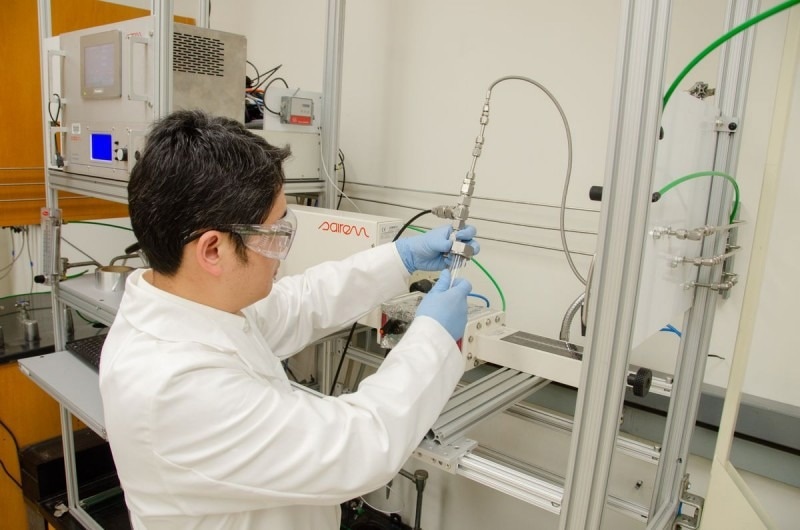Reviewed by Lexie CornerOct 22 2024
Research from West Virginia University could soon make polypropylene—a plastic commonly used in lawn chairs, auto parts, food packaging, and apparel—more environmentally friendly.
 WVU researcher Yuxin Wang loads polypropylene into a microwave reactor. Wang is leading a study that explores the use of microwave technology in plastic upcycling. Image Credit: Paige Nesbit
WVU researcher Yuxin Wang loads polypropylene into a microwave reactor. Wang is leading a study that explores the use of microwave technology in plastic upcycling. Image Credit: Paige Nesbit
Polypropylene is the second most produced plastic resin globally after polyethylene. It is found in items like kitchenware, athletic gear, bleach bottles, pipes, battery casings, medical equipment, and fabrics. Single-use plastics, such as fast food to-go cups, are predominantly made of polypropylene, and most end up as waste in landfills or harm the environment.
Wang, a Chemical Engineer at WVU, is exploring the recovery of the chemical compound propylene from outdated polypropylene products using microwave technology, supported by a $1 million grant from the US Department of Energy.
We need to diversify our strategies for dealing with America’s abundant plastic waste. Currently, polypropylene has a notably low recovery rate of only 1 %, meaning 99 % of polypropylene products become garbage. We want to change that by using microwave irradiation to recover propylene from polypropylene.
Yuxin Wang, Chemical Engineer and Assistant Professor, West Virginia University
Wang, in collaboration with Srinivas Palanki, Chair of the Department of Chemical and Biomedical Engineering, will investigate energy-efficient methods to convert polypropylene back into propylene, which can then be reused in new polymers or other products.
We make 150.3 million metric tons of propylene every year through energy-intensive processes like ethane steam cracking. These processes require very high temperatures. If we can recover usable propylene from polypropylene, we will reduce energy and emissions throughout the lifecycle of these plastics, and we will improve productivity and efficiency for U.S. manufacturers.
Srinivas Palanki, Chair, Department of Chemical and Biomedical Engineering, West Virginia University
While other researchers have attempted to recover propylene from polypropylene waste using thermochemical techniques like pyrolysis—heating the material in an oxygen-free environment—Wang explained that polypropylene has largely resisted these efforts so far.
He said, “The pyrolysis of polypropylene typically results in a propylene yield of less than 25 %, even with an optimized process. Our challenge is to use microwaves to do it in a way that is cost-competitive and can be practically implemented.”
Wang noted two key advantages of using microwaves as an energy source: precise, selective control of the process and the ability to recover propylene at much lower temperatures, such as 300 ℃, compared to the 600-700 ℃ typically required in traditional thermal recovery methods.
In Wang and Palanki's approach, microwave radiation heats an intermediary "catalyst" material, which then transfers the heat to the polypropylene waste.
Their aim is to "upcycle" polypropylene, a recycling method that breaks materials down into their original chemical components, which can then be reused to create new products. This differs from conventional recycling, which typically reduces materials into small pieces for reuse.
In recycling, you crush a water bottle into small pieces and then use those pieces to build a bottle again. Recycling limits your utilization. We want to generate chemicals that not only can be used to manufacture polypropylene again but also can be valuable in other reactions.
Yuxin Wang, Chemical Engineer and Assistant Professor, West Virginia University
The study will also introduce WVU graduate and undergraduate students to the Advanced Photon Source facility's resources at the Argonne National Laboratory in Illinois.
“APS has cutting-edge technology that we will use in this project, and this is a great opportunity to build the relationship between our academic research program and a national lab,” Wang said.
“As part of this study, WVU students will be able to use new techniques developed at APS for use in the Argonne ‘synchrotron,’ a kind of particle accelerator. The students will work with Argonne engineers like Tao Li, from Northern Illinois University, who is an expert in the catalytic reaction processes we are interested in. They will learn plastic upcycling mechanisms and become part of the solution for our plastic waste issue,” Wang concludes.